The Role of Supply Chain Management in Zara's Competitive Advantage
VerifiedAdded on 2023/04/17
|9
|1847
|380
Report
AI Summary
This report examines Zara's supply chain management and its impact on creating a competitive advantage in the fast fashion industry. It discusses the strengths of Zara's supply chain, such as its ability to quickly refresh merchandise displays, cost-effectiveness through a mix of in-house and outsourced production, and efficient information flow. The report also acknowledges weaknesses, including sustainability concerns and labor issues. Ultimately, the responsive supply chain enables Zara to offer trendy, affordable fashion, contributing to its market leadership and profitability. Desklib offers access to this and similar solved assignments for students.
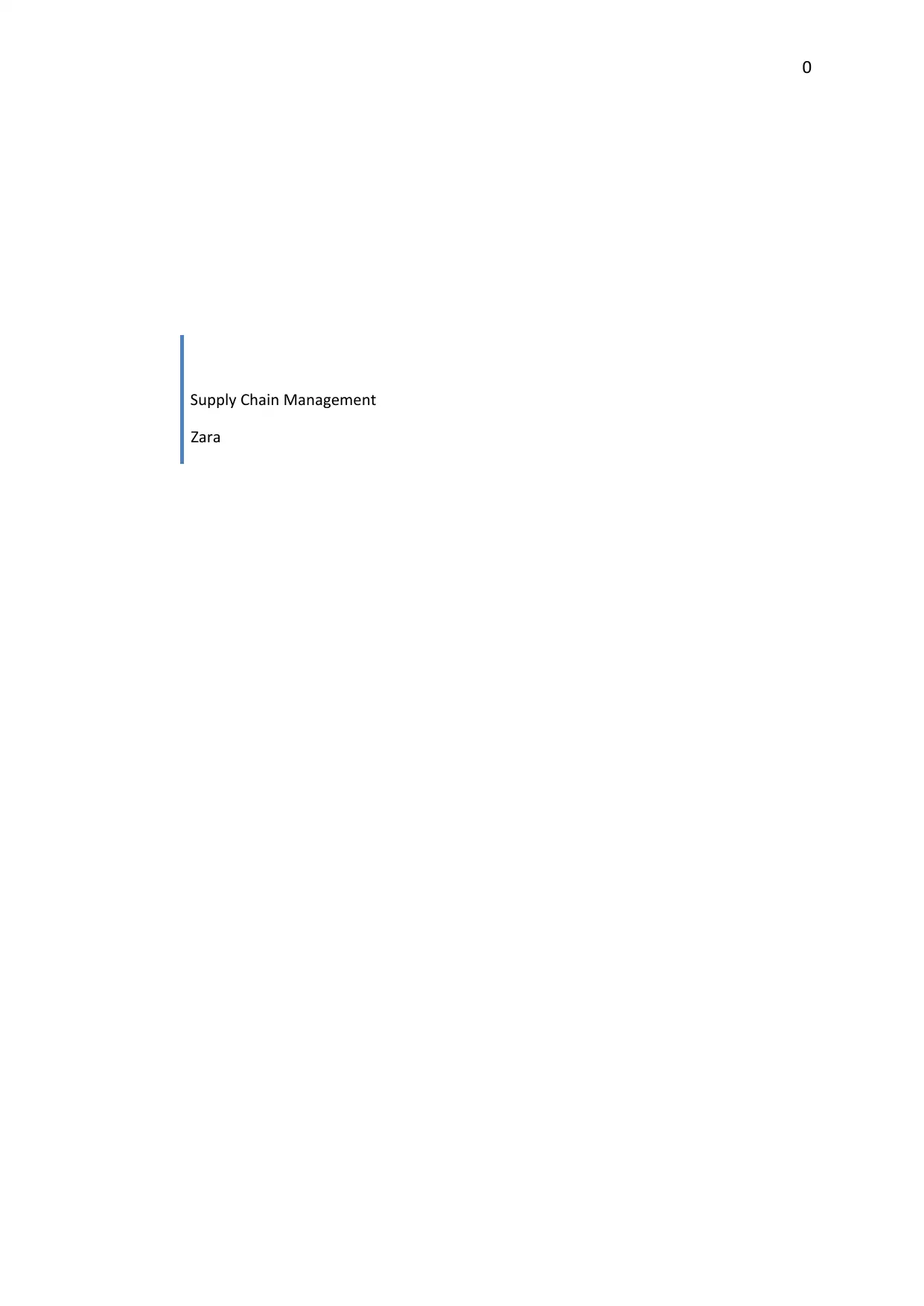
0
Supply Chain Management
Zara
Supply Chain Management
Zara
Paraphrase This Document
Need a fresh take? Get an instant paraphrase of this document with our AI Paraphraser
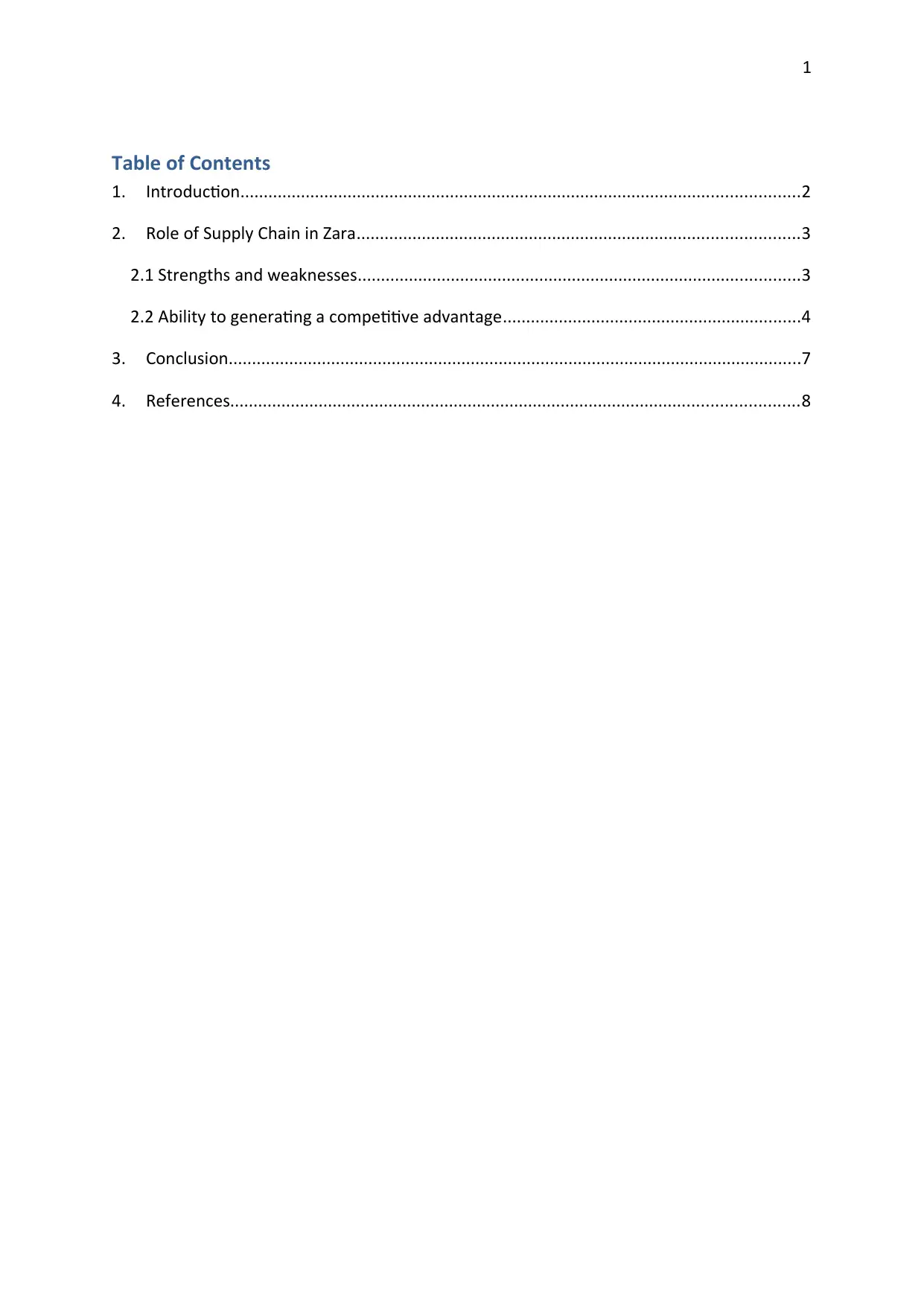
1
Table of Contents
1. Introduction........................................................................................................................2
2. Role of Supply Chain in Zara...............................................................................................3
2.1 Strengths and weaknesses...............................................................................................3
2.2 Ability to generating a competitive advantage................................................................4
3. Conclusion...........................................................................................................................7
4. References..........................................................................................................................8
Table of Contents
1. Introduction........................................................................................................................2
2. Role of Supply Chain in Zara...............................................................................................3
2.1 Strengths and weaknesses...............................................................................................3
2.2 Ability to generating a competitive advantage................................................................4
3. Conclusion...........................................................................................................................7
4. References..........................................................................................................................8
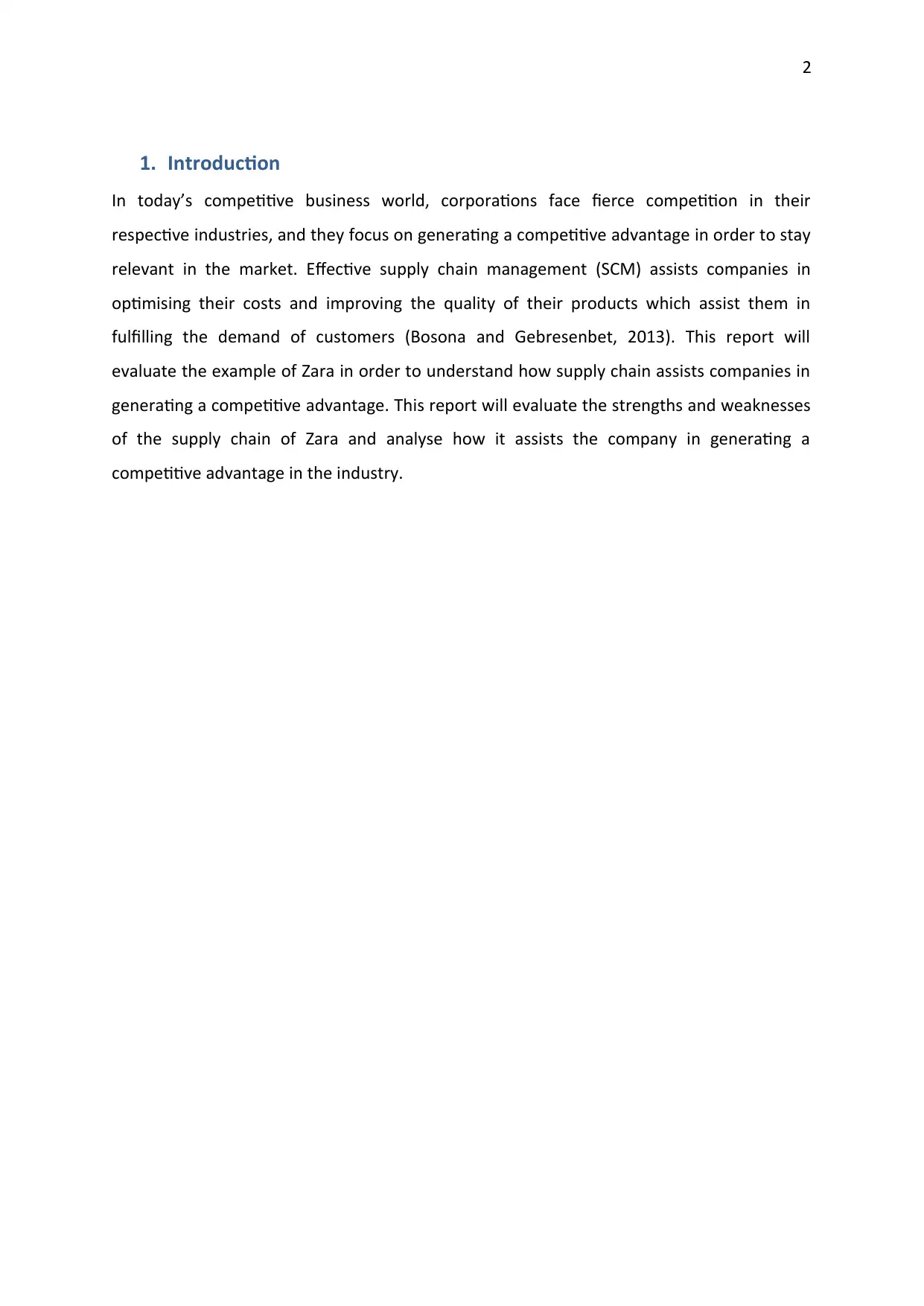
2
1. Introduction
In today’s competitive business world, corporations face fierce competition in their
respective industries, and they focus on generating a competitive advantage in order to stay
relevant in the market. Effective supply chain management (SCM) assists companies in
optimising their costs and improving the quality of their products which assist them in
fulfilling the demand of customers (Bosona and Gebresenbet, 2013). This report will
evaluate the example of Zara in order to understand how supply chain assists companies in
generating a competitive advantage. This report will evaluate the strengths and weaknesses
of the supply chain of Zara and analyse how it assists the company in generating a
competitive advantage in the industry.
1. Introduction
In today’s competitive business world, corporations face fierce competition in their
respective industries, and they focus on generating a competitive advantage in order to stay
relevant in the market. Effective supply chain management (SCM) assists companies in
optimising their costs and improving the quality of their products which assist them in
fulfilling the demand of customers (Bosona and Gebresenbet, 2013). This report will
evaluate the example of Zara in order to understand how supply chain assists companies in
generating a competitive advantage. This report will evaluate the strengths and weaknesses
of the supply chain of Zara and analyse how it assists the company in generating a
competitive advantage in the industry.
⊘ This is a preview!⊘
Do you want full access?
Subscribe today to unlock all pages.

Trusted by 1+ million students worldwide
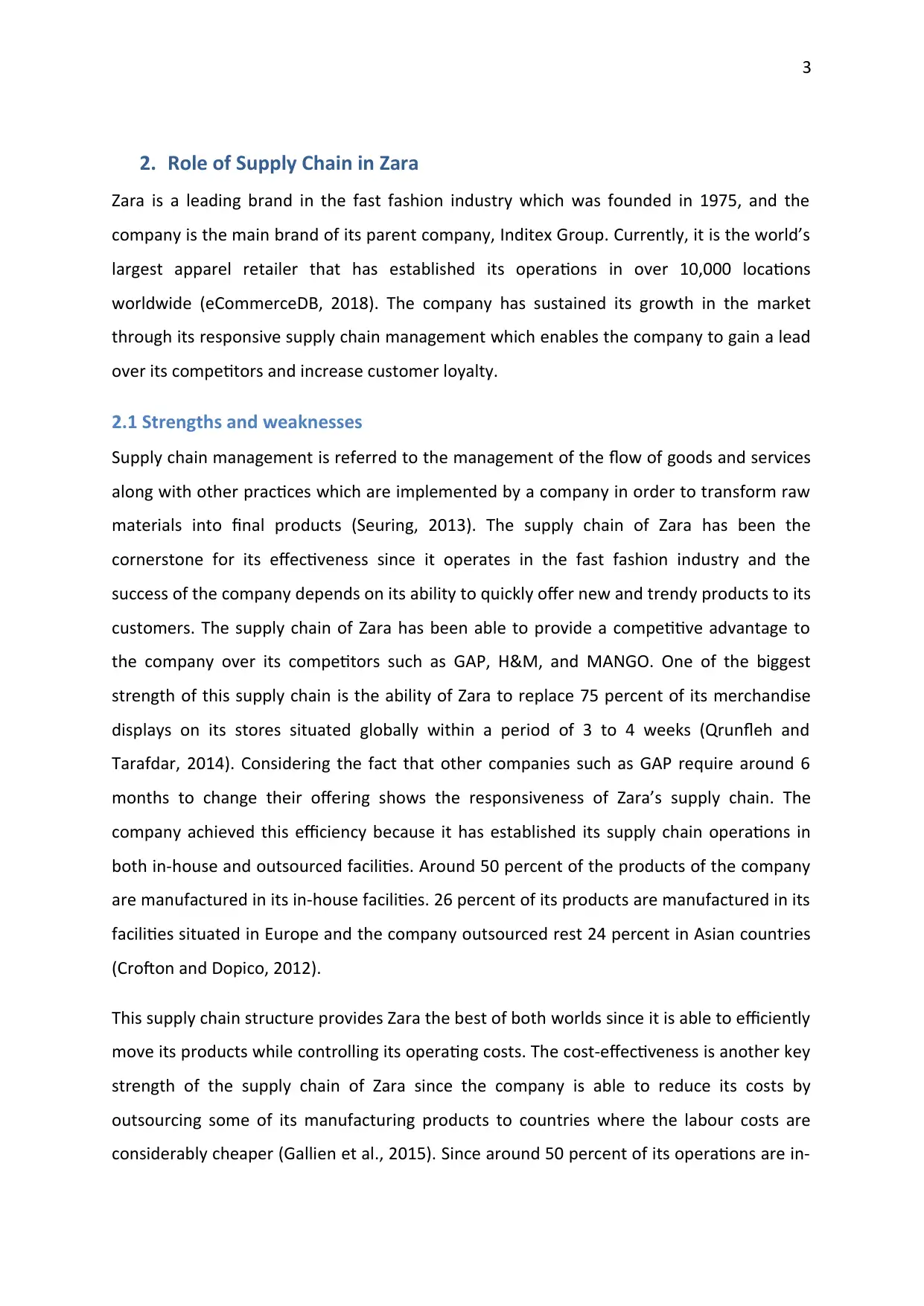
3
2. Role of Supply Chain in Zara
Zara is a leading brand in the fast fashion industry which was founded in 1975, and the
company is the main brand of its parent company, Inditex Group. Currently, it is the world’s
largest apparel retailer that has established its operations in over 10,000 locations
worldwide (eCommerceDB, 2018). The company has sustained its growth in the market
through its responsive supply chain management which enables the company to gain a lead
over its competitors and increase customer loyalty.
2.1 Strengths and weaknesses
Supply chain management is referred to the management of the flow of goods and services
along with other practices which are implemented by a company in order to transform raw
materials into final products (Seuring, 2013). The supply chain of Zara has been the
cornerstone for its effectiveness since it operates in the fast fashion industry and the
success of the company depends on its ability to quickly offer new and trendy products to its
customers. The supply chain of Zara has been able to provide a competitive advantage to
the company over its competitors such as GAP, H&M, and MANGO. One of the biggest
strength of this supply chain is the ability of Zara to replace 75 percent of its merchandise
displays on its stores situated globally within a period of 3 to 4 weeks (Qrunfleh and
Tarafdar, 2014). Considering the fact that other companies such as GAP require around 6
months to change their offering shows the responsiveness of Zara’s supply chain. The
company achieved this efficiency because it has established its supply chain operations in
both in-house and outsourced facilities. Around 50 percent of the products of the company
are manufactured in its in-house facilities. 26 percent of its products are manufactured in its
facilities situated in Europe and the company outsourced rest 24 percent in Asian countries
(Crofton and Dopico, 2012).
This supply chain structure provides Zara the best of both worlds since it is able to efficiently
move its products while controlling its operating costs. The cost-effectiveness is another key
strength of the supply chain of Zara since the company is able to reduce its costs by
outsourcing some of its manufacturing products to countries where the labour costs are
considerably cheaper (Gallien et al., 2015). Since around 50 percent of its operations are in-
2. Role of Supply Chain in Zara
Zara is a leading brand in the fast fashion industry which was founded in 1975, and the
company is the main brand of its parent company, Inditex Group. Currently, it is the world’s
largest apparel retailer that has established its operations in over 10,000 locations
worldwide (eCommerceDB, 2018). The company has sustained its growth in the market
through its responsive supply chain management which enables the company to gain a lead
over its competitors and increase customer loyalty.
2.1 Strengths and weaknesses
Supply chain management is referred to the management of the flow of goods and services
along with other practices which are implemented by a company in order to transform raw
materials into final products (Seuring, 2013). The supply chain of Zara has been the
cornerstone for its effectiveness since it operates in the fast fashion industry and the
success of the company depends on its ability to quickly offer new and trendy products to its
customers. The supply chain of Zara has been able to provide a competitive advantage to
the company over its competitors such as GAP, H&M, and MANGO. One of the biggest
strength of this supply chain is the ability of Zara to replace 75 percent of its merchandise
displays on its stores situated globally within a period of 3 to 4 weeks (Qrunfleh and
Tarafdar, 2014). Considering the fact that other companies such as GAP require around 6
months to change their offering shows the responsiveness of Zara’s supply chain. The
company achieved this efficiency because it has established its supply chain operations in
both in-house and outsourced facilities. Around 50 percent of the products of the company
are manufactured in its in-house facilities. 26 percent of its products are manufactured in its
facilities situated in Europe and the company outsourced rest 24 percent in Asian countries
(Crofton and Dopico, 2012).
This supply chain structure provides Zara the best of both worlds since it is able to efficiently
move its products while controlling its operating costs. The cost-effectiveness is another key
strength of the supply chain of Zara since the company is able to reduce its costs by
outsourcing some of its manufacturing products to countries where the labour costs are
considerably cheaper (Gallien et al., 2015). Since around 50 percent of its operations are in-
Paraphrase This Document
Need a fresh take? Get an instant paraphrase of this document with our AI Paraphraser
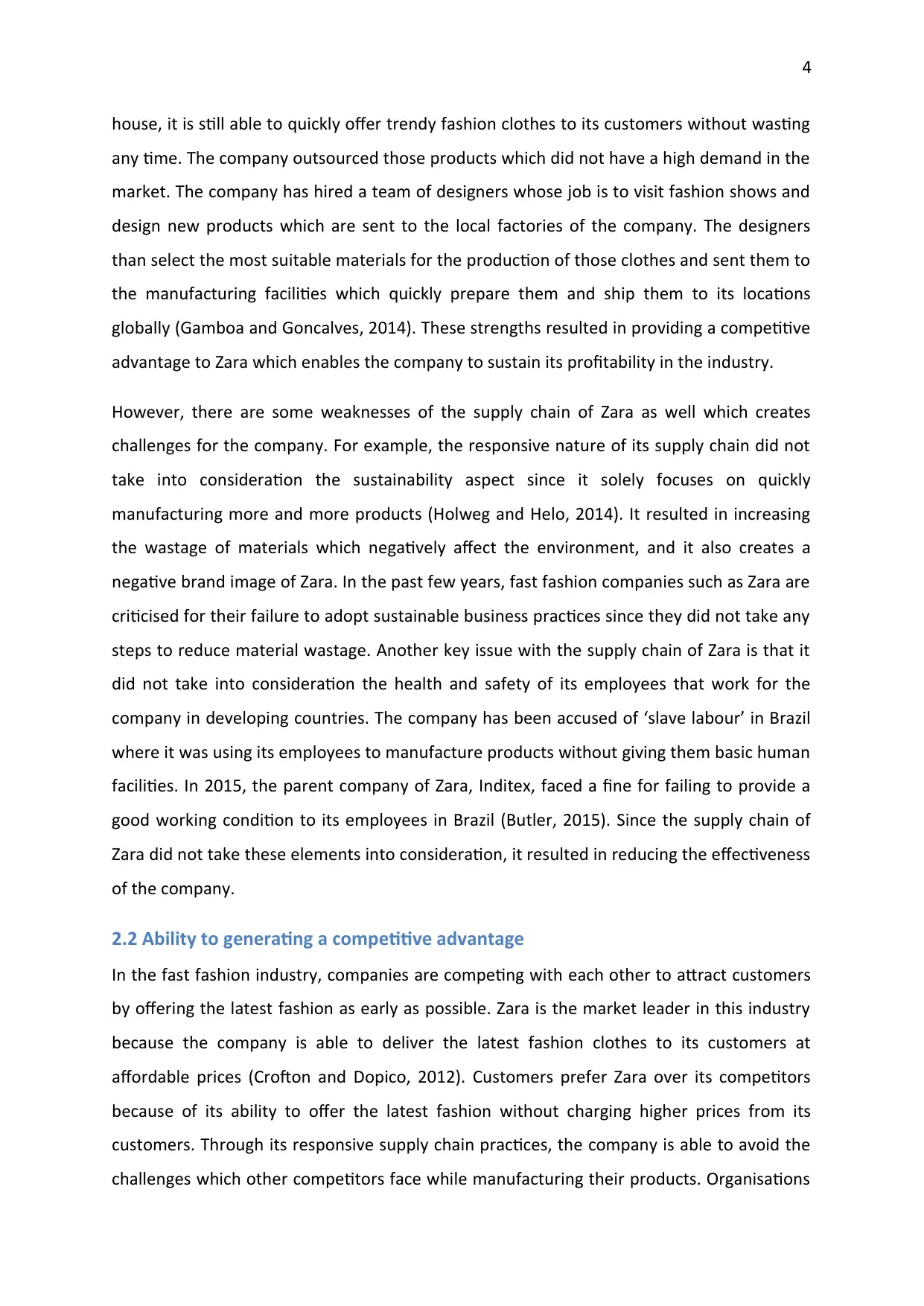
4
house, it is still able to quickly offer trendy fashion clothes to its customers without wasting
any time. The company outsourced those products which did not have a high demand in the
market. The company has hired a team of designers whose job is to visit fashion shows and
design new products which are sent to the local factories of the company. The designers
than select the most suitable materials for the production of those clothes and sent them to
the manufacturing facilities which quickly prepare them and ship them to its locations
globally (Gamboa and Goncalves, 2014). These strengths resulted in providing a competitive
advantage to Zara which enables the company to sustain its profitability in the industry.
However, there are some weaknesses of the supply chain of Zara as well which creates
challenges for the company. For example, the responsive nature of its supply chain did not
take into consideration the sustainability aspect since it solely focuses on quickly
manufacturing more and more products (Holweg and Helo, 2014). It resulted in increasing
the wastage of materials which negatively affect the environment, and it also creates a
negative brand image of Zara. In the past few years, fast fashion companies such as Zara are
criticised for their failure to adopt sustainable business practices since they did not take any
steps to reduce material wastage. Another key issue with the supply chain of Zara is that it
did not take into consideration the health and safety of its employees that work for the
company in developing countries. The company has been accused of ‘slave labour’ in Brazil
where it was using its employees to manufacture products without giving them basic human
facilities. In 2015, the parent company of Zara, Inditex, faced a fine for failing to provide a
good working condition to its employees in Brazil (Butler, 2015). Since the supply chain of
Zara did not take these elements into consideration, it resulted in reducing the effectiveness
of the company.
2.2 Ability to generating a competitive advantage
In the fast fashion industry, companies are competing with each other to attract customers
by offering the latest fashion as early as possible. Zara is the market leader in this industry
because the company is able to deliver the latest fashion clothes to its customers at
affordable prices (Crofton and Dopico, 2012). Customers prefer Zara over its competitors
because of its ability to offer the latest fashion without charging higher prices from its
customers. Through its responsive supply chain practices, the company is able to avoid the
challenges which other competitors face while manufacturing their products. Organisations
house, it is still able to quickly offer trendy fashion clothes to its customers without wasting
any time. The company outsourced those products which did not have a high demand in the
market. The company has hired a team of designers whose job is to visit fashion shows and
design new products which are sent to the local factories of the company. The designers
than select the most suitable materials for the production of those clothes and sent them to
the manufacturing facilities which quickly prepare them and ship them to its locations
globally (Gamboa and Goncalves, 2014). These strengths resulted in providing a competitive
advantage to Zara which enables the company to sustain its profitability in the industry.
However, there are some weaknesses of the supply chain of Zara as well which creates
challenges for the company. For example, the responsive nature of its supply chain did not
take into consideration the sustainability aspect since it solely focuses on quickly
manufacturing more and more products (Holweg and Helo, 2014). It resulted in increasing
the wastage of materials which negatively affect the environment, and it also creates a
negative brand image of Zara. In the past few years, fast fashion companies such as Zara are
criticised for their failure to adopt sustainable business practices since they did not take any
steps to reduce material wastage. Another key issue with the supply chain of Zara is that it
did not take into consideration the health and safety of its employees that work for the
company in developing countries. The company has been accused of ‘slave labour’ in Brazil
where it was using its employees to manufacture products without giving them basic human
facilities. In 2015, the parent company of Zara, Inditex, faced a fine for failing to provide a
good working condition to its employees in Brazil (Butler, 2015). Since the supply chain of
Zara did not take these elements into consideration, it resulted in reducing the effectiveness
of the company.
2.2 Ability to generating a competitive advantage
In the fast fashion industry, companies are competing with each other to attract customers
by offering the latest fashion as early as possible. Zara is the market leader in this industry
because the company is able to deliver the latest fashion clothes to its customers at
affordable prices (Crofton and Dopico, 2012). Customers prefer Zara over its competitors
because of its ability to offer the latest fashion without charging higher prices from its
customers. Through its responsive supply chain practices, the company is able to avoid the
challenges which other competitors face while manufacturing their products. Organisations
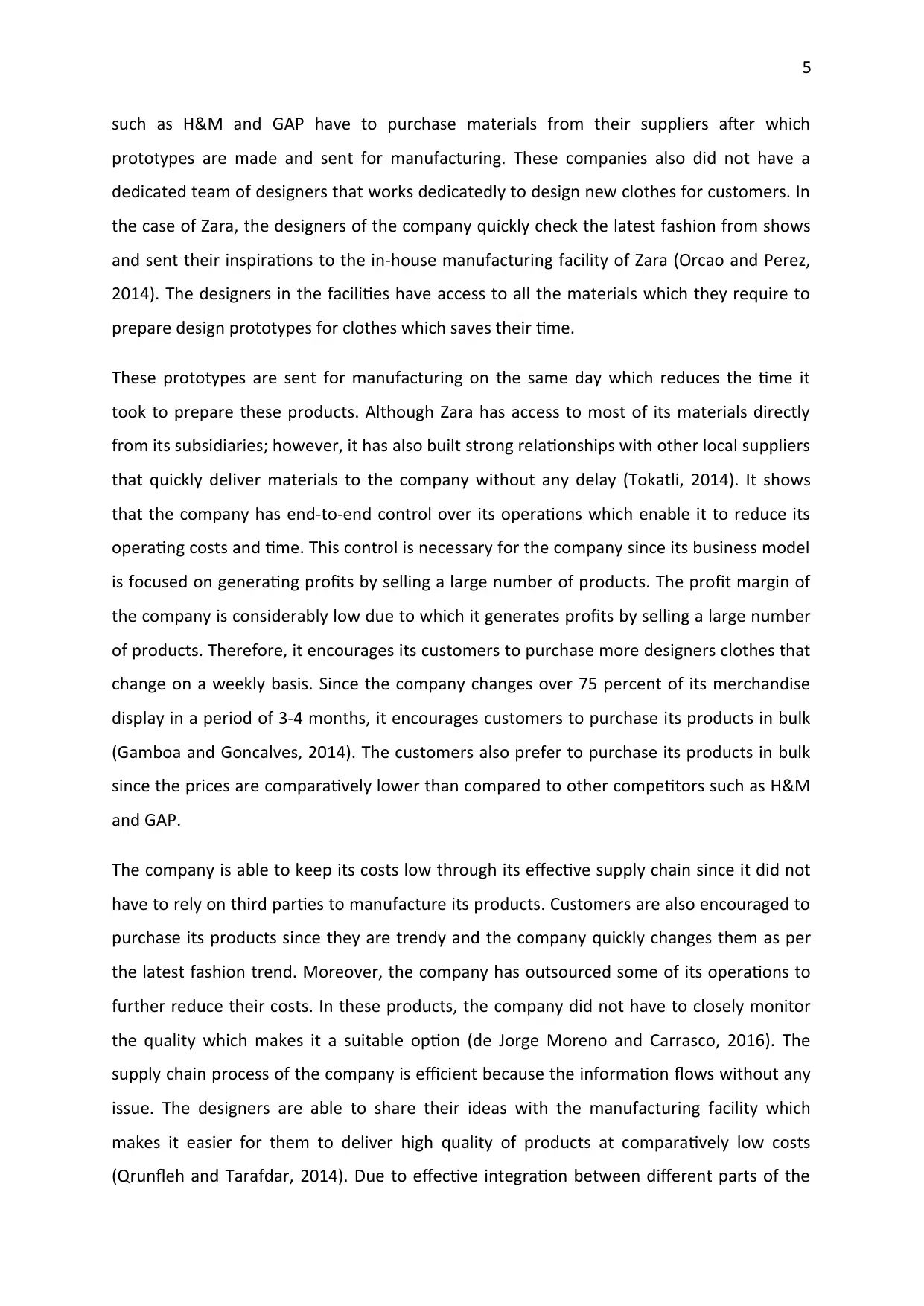
5
such as H&M and GAP have to purchase materials from their suppliers after which
prototypes are made and sent for manufacturing. These companies also did not have a
dedicated team of designers that works dedicatedly to design new clothes for customers. In
the case of Zara, the designers of the company quickly check the latest fashion from shows
and sent their inspirations to the in-house manufacturing facility of Zara (Orcao and Perez,
2014). The designers in the facilities have access to all the materials which they require to
prepare design prototypes for clothes which saves their time.
These prototypes are sent for manufacturing on the same day which reduces the time it
took to prepare these products. Although Zara has access to most of its materials directly
from its subsidiaries; however, it has also built strong relationships with other local suppliers
that quickly deliver materials to the company without any delay (Tokatli, 2014). It shows
that the company has end-to-end control over its operations which enable it to reduce its
operating costs and time. This control is necessary for the company since its business model
is focused on generating profits by selling a large number of products. The profit margin of
the company is considerably low due to which it generates profits by selling a large number
of products. Therefore, it encourages its customers to purchase more designers clothes that
change on a weekly basis. Since the company changes over 75 percent of its merchandise
display in a period of 3-4 months, it encourages customers to purchase its products in bulk
(Gamboa and Goncalves, 2014). The customers also prefer to purchase its products in bulk
since the prices are comparatively lower than compared to other competitors such as H&M
and GAP.
The company is able to keep its costs low through its effective supply chain since it did not
have to rely on third parties to manufacture its products. Customers are also encouraged to
purchase its products since they are trendy and the company quickly changes them as per
the latest fashion trend. Moreover, the company has outsourced some of its operations to
further reduce their costs. In these products, the company did not have to closely monitor
the quality which makes it a suitable option (de Jorge Moreno and Carrasco, 2016). The
supply chain process of the company is efficient because the information flows without any
issue. The designers are able to share their ideas with the manufacturing facility which
makes it easier for them to deliver high quality of products at comparatively low costs
(Qrunfleh and Tarafdar, 2014). Due to effective integration between different parts of the
such as H&M and GAP have to purchase materials from their suppliers after which
prototypes are made and sent for manufacturing. These companies also did not have a
dedicated team of designers that works dedicatedly to design new clothes for customers. In
the case of Zara, the designers of the company quickly check the latest fashion from shows
and sent their inspirations to the in-house manufacturing facility of Zara (Orcao and Perez,
2014). The designers in the facilities have access to all the materials which they require to
prepare design prototypes for clothes which saves their time.
These prototypes are sent for manufacturing on the same day which reduces the time it
took to prepare these products. Although Zara has access to most of its materials directly
from its subsidiaries; however, it has also built strong relationships with other local suppliers
that quickly deliver materials to the company without any delay (Tokatli, 2014). It shows
that the company has end-to-end control over its operations which enable it to reduce its
operating costs and time. This control is necessary for the company since its business model
is focused on generating profits by selling a large number of products. The profit margin of
the company is considerably low due to which it generates profits by selling a large number
of products. Therefore, it encourages its customers to purchase more designers clothes that
change on a weekly basis. Since the company changes over 75 percent of its merchandise
display in a period of 3-4 months, it encourages customers to purchase its products in bulk
(Gamboa and Goncalves, 2014). The customers also prefer to purchase its products in bulk
since the prices are comparatively lower than compared to other competitors such as H&M
and GAP.
The company is able to keep its costs low through its effective supply chain since it did not
have to rely on third parties to manufacture its products. Customers are also encouraged to
purchase its products since they are trendy and the company quickly changes them as per
the latest fashion trend. Moreover, the company has outsourced some of its operations to
further reduce their costs. In these products, the company did not have to closely monitor
the quality which makes it a suitable option (de Jorge Moreno and Carrasco, 2016). The
supply chain process of the company is efficient because the information flows without any
issue. The designers are able to share their ideas with the manufacturing facility which
makes it easier for them to deliver high quality of products at comparatively low costs
(Qrunfleh and Tarafdar, 2014). Due to effective integration between different parts of the
⊘ This is a preview!⊘
Do you want full access?
Subscribe today to unlock all pages.

Trusted by 1+ million students worldwide
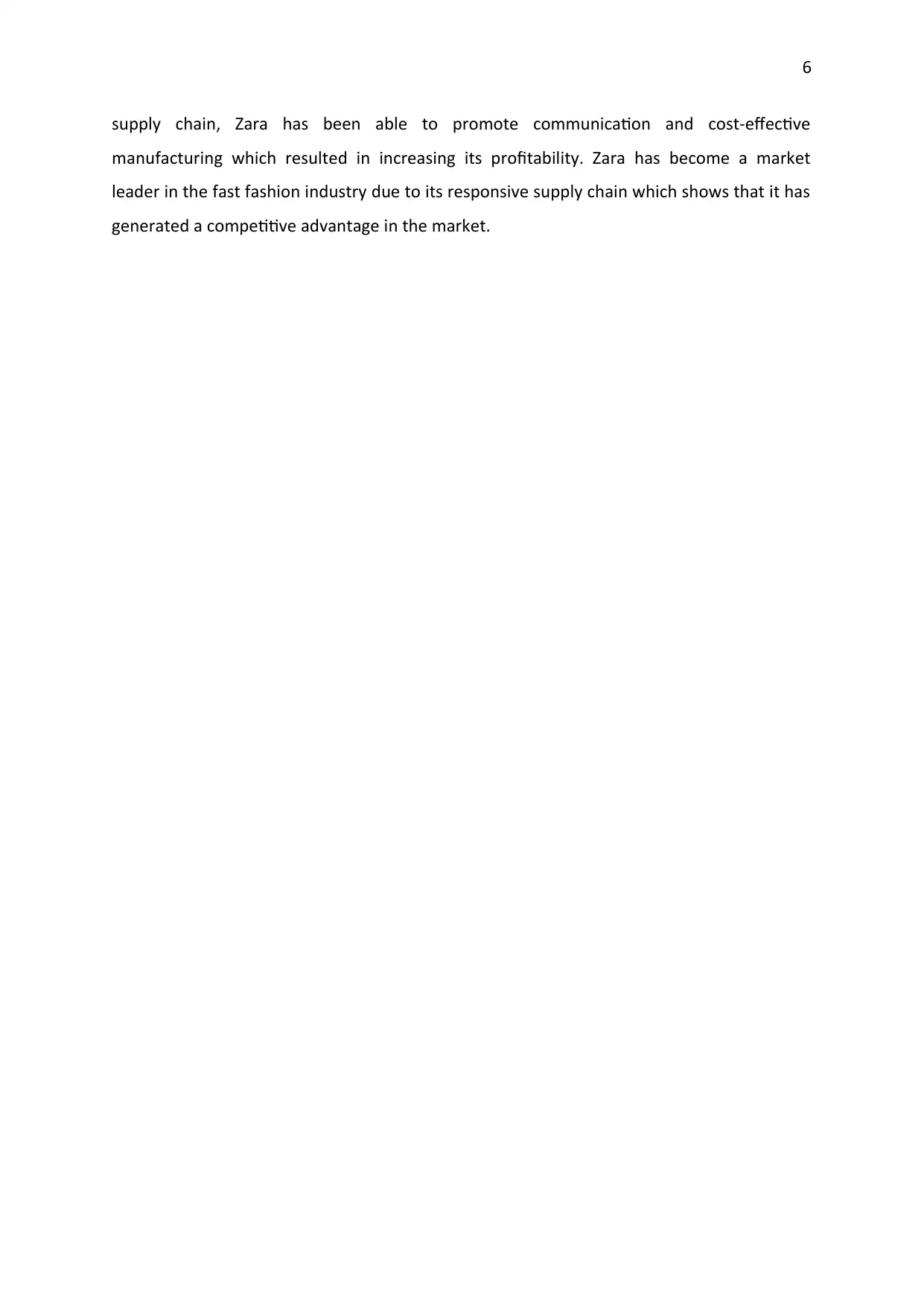
6
supply chain, Zara has been able to promote communication and cost-effective
manufacturing which resulted in increasing its profitability. Zara has become a market
leader in the fast fashion industry due to its responsive supply chain which shows that it has
generated a competitive advantage in the market.
supply chain, Zara has been able to promote communication and cost-effective
manufacturing which resulted in increasing its profitability. Zara has become a market
leader in the fast fashion industry due to its responsive supply chain which shows that it has
generated a competitive advantage in the market.
Paraphrase This Document
Need a fresh take? Get an instant paraphrase of this document with our AI Paraphraser

7
3. Conclusion
In conclusion, effective management of supply chain assist companies in generating a
competitive advantage and efficiently perform their operations which is crucial to increase
their profitability. The supply chain of Zara has various strengths such as its ability to change
its global merchandise display within a period of 3-4 weeks, reduce the cost of operations
and efficiently flow its products from design to stores. However, its weaknesses include high
number of wastage of materials and bad working conditions of labours. The responsive SCM
of Zara enables the company to offer designer products to its customers without wasting
any time which provides it a competitive advantage in the fast fashion industry. Without its
supply chain, Zara cannot remain incumbent in the fast fashion industry which shows the
importance of its supply chain which enables the company to generate a competitive
advantage and sustain its profitability in the market.
3. Conclusion
In conclusion, effective management of supply chain assist companies in generating a
competitive advantage and efficiently perform their operations which is crucial to increase
their profitability. The supply chain of Zara has various strengths such as its ability to change
its global merchandise display within a period of 3-4 weeks, reduce the cost of operations
and efficiently flow its products from design to stores. However, its weaknesses include high
number of wastage of materials and bad working conditions of labours. The responsive SCM
of Zara enables the company to offer designer products to its customers without wasting
any time which provides it a competitive advantage in the fast fashion industry. Without its
supply chain, Zara cannot remain incumbent in the fast fashion industry which shows the
importance of its supply chain which enables the company to generate a competitive
advantage and sustain its profitability in the market.
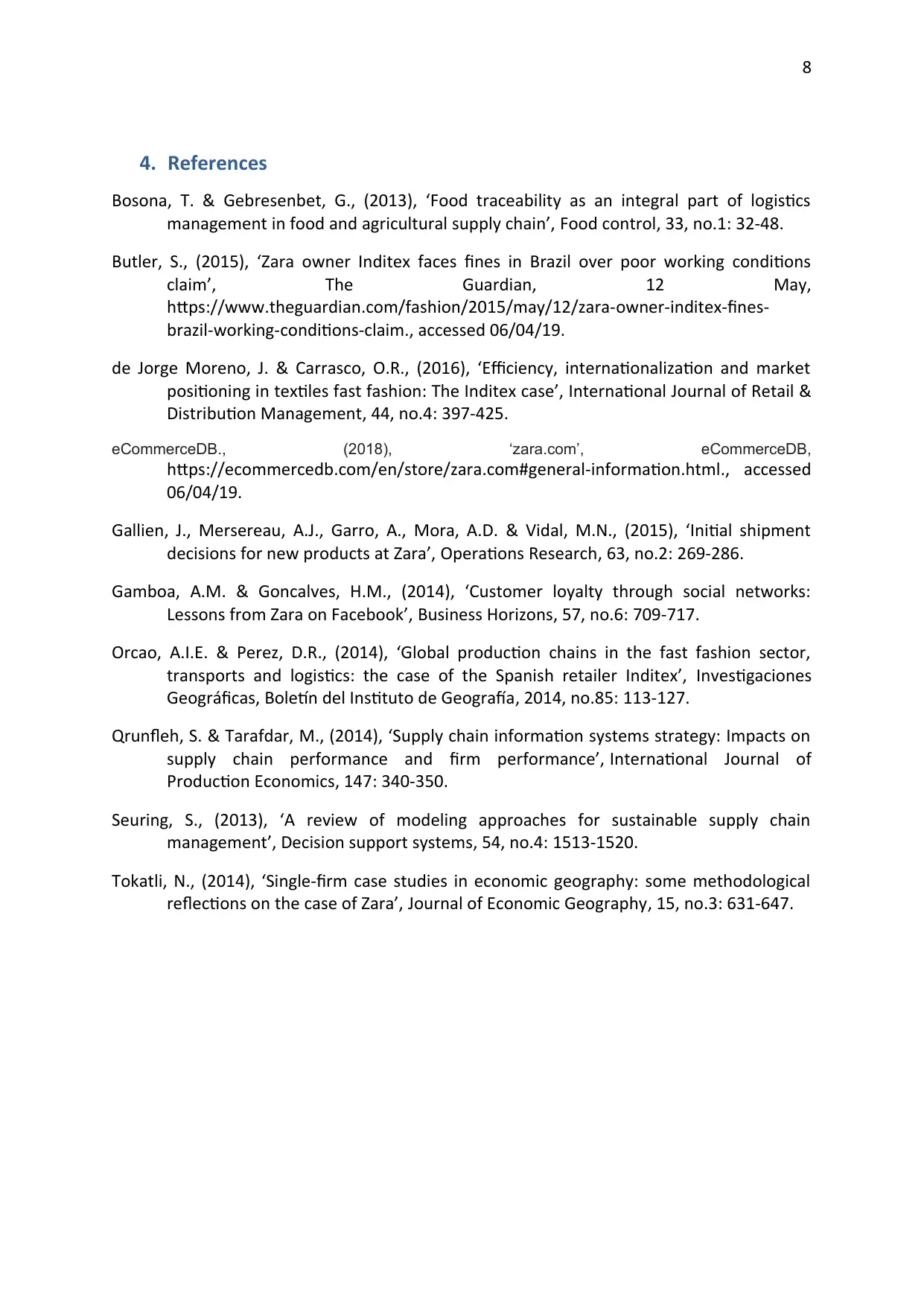
8
4. References
Bosona, T. & Gebresenbet, G., (2013), ‘Food traceability as an integral part of logistics
management in food and agricultural supply chain’, Food control, 33, no.1: 32-48.
Butler, S., (2015), ‘Zara owner Inditex faces fines in Brazil over poor working conditions
claim’, The Guardian, 12 May,
https://www.theguardian.com/fashion/2015/may/12/zara-owner-inditex-fines-
brazil-working-conditions-claim., accessed 06/04/19.
de Jorge Moreno, J. & Carrasco, O.R., (2016), ‘Efficiency, internationalization and market
positioning in textiles fast fashion: The Inditex case’, International Journal of Retail &
Distribution Management, 44, no.4: 397-425.
eCommerceDB., (2018), ‘zara.com’, eCommerceDB,
https://ecommercedb.com/en/store/zara.com#general-information.html., accessed
06/04/19.
Gallien, J., Mersereau, A.J., Garro, A., Mora, A.D. & Vidal, M.N., (2015), ‘Initial shipment
decisions for new products at Zara’, Operations Research, 63, no.2: 269-286.
Gamboa, A.M. & Goncalves, H.M., (2014), ‘Customer loyalty through social networks:
Lessons from Zara on Facebook’, Business Horizons, 57, no.6: 709-717.
Orcao, A.I.E. & Perez, D.R., (2014), ‘Global production chains in the fast fashion sector,
transports and logistics: the case of the Spanish retailer Inditex’, Investigaciones
Geográficas, Boletín del Instituto de Geografía, 2014, no.85: 113-127.
Qrunfleh, S. & Tarafdar, M., (2014), ‘Supply chain information systems strategy: Impacts on
supply chain performance and firm performance’, International Journal of
Production Economics, 147: 340-350.
Seuring, S., (2013), ‘A review of modeling approaches for sustainable supply chain
management’, Decision support systems, 54, no.4: 1513-1520.
Tokatli, N., (2014), ‘Single-firm case studies in economic geography: some methodological
reflections on the case of Zara’, Journal of Economic Geography, 15, no.3: 631-647.
4. References
Bosona, T. & Gebresenbet, G., (2013), ‘Food traceability as an integral part of logistics
management in food and agricultural supply chain’, Food control, 33, no.1: 32-48.
Butler, S., (2015), ‘Zara owner Inditex faces fines in Brazil over poor working conditions
claim’, The Guardian, 12 May,
https://www.theguardian.com/fashion/2015/may/12/zara-owner-inditex-fines-
brazil-working-conditions-claim., accessed 06/04/19.
de Jorge Moreno, J. & Carrasco, O.R., (2016), ‘Efficiency, internationalization and market
positioning in textiles fast fashion: The Inditex case’, International Journal of Retail &
Distribution Management, 44, no.4: 397-425.
eCommerceDB., (2018), ‘zara.com’, eCommerceDB,
https://ecommercedb.com/en/store/zara.com#general-information.html., accessed
06/04/19.
Gallien, J., Mersereau, A.J., Garro, A., Mora, A.D. & Vidal, M.N., (2015), ‘Initial shipment
decisions for new products at Zara’, Operations Research, 63, no.2: 269-286.
Gamboa, A.M. & Goncalves, H.M., (2014), ‘Customer loyalty through social networks:
Lessons from Zara on Facebook’, Business Horizons, 57, no.6: 709-717.
Orcao, A.I.E. & Perez, D.R., (2014), ‘Global production chains in the fast fashion sector,
transports and logistics: the case of the Spanish retailer Inditex’, Investigaciones
Geográficas, Boletín del Instituto de Geografía, 2014, no.85: 113-127.
Qrunfleh, S. & Tarafdar, M., (2014), ‘Supply chain information systems strategy: Impacts on
supply chain performance and firm performance’, International Journal of
Production Economics, 147: 340-350.
Seuring, S., (2013), ‘A review of modeling approaches for sustainable supply chain
management’, Decision support systems, 54, no.4: 1513-1520.
Tokatli, N., (2014), ‘Single-firm case studies in economic geography: some methodological
reflections on the case of Zara’, Journal of Economic Geography, 15, no.3: 631-647.
⊘ This is a preview!⊘
Do you want full access?
Subscribe today to unlock all pages.

Trusted by 1+ million students worldwide
1 out of 9
Related Documents
Your All-in-One AI-Powered Toolkit for Academic Success.
+13062052269
info@desklib.com
Available 24*7 on WhatsApp / Email
![[object Object]](/_next/static/media/star-bottom.7253800d.svg)
Unlock your academic potential
Copyright © 2020–2025 A2Z Services. All Rights Reserved. Developed and managed by ZUCOL.





